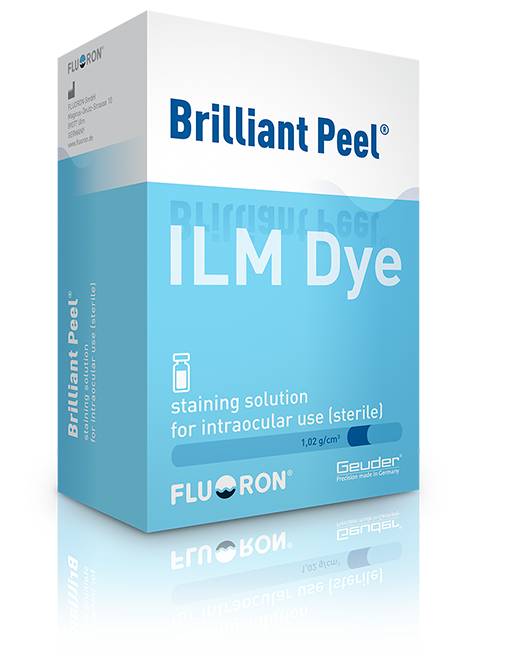Brilliant Peel®
Heavy dye for selective staining

Brilliant Peel®
Vial G-81010 Brilliant Peel® 0,5 ml, sterile
Syringe G-81005 Brilliant Peel® 0,5 ml, sterile
- Precise and intense staining of the ILM due to fast sinking dye
- Safe application under air and BSS
- Quick and easy application (Ready-to-use)
- Physiological osmolarity
- Biocompatible
Composition and properties of Brilliant Peel®
Composition of one 0.5 ml syringe / vial:
0,125 mg Brilliant Blue G
0,95 mg Na2HPO4 x 2 H2O
0,15 mg NaH2PO4 x 2 H2O
4,1 mg NaCl
0,065 ml D2O
ad 0,5 ml water for injection purposes
Concentration:
0,25 g/l Brilliant Blue G
Density:
1,02 g/cm3
Fields of application
Brilliant Peel® was developed for specific staining of the inner limiting membrane (ILM). Specific staining of the ILM allows it to be clearly differentiated from the underlying retinal tissue and the epiretinal membranes. Due to the density of 1.02 g/cm3 Brilliant Peel® quickly sinks to to the fundus of the eye without diffuse dispersion in the whole bulbus. The surgically demanding removal of the ILM thus becomes easier and safer.
| Characteristics | Brilliant Peel® | Other Dyes | |||
|---|---|---|---|---|---|
| BBG | ICG | TB | Acid Violet-17 | Lutein | |
| Chemical Classification | Triphenylmethane | Cyanine | Diazo | Triphenylmethane | Carotinoide |
| Color | Blue | Green | Blue | Violet | Yellow-Orange |
| Dye 12 | Brillant Blau G | Indocyanine Green | Trypan Blue | Acid Violet-17 | Lutein |
| Toxicity 1, 2, 3, 6, 7, 9, 10, 12, 13 | no | yes | moderate | moderate | no |
| Approval | yes | no | yes | yes | yes |
| Affinity for ILM 4, 5, 8, 14, 15 | high | high | low | high | low |
| Affinity for ERM 2, 14 | niedrig | low | high | low | n.a. |
| Affinity for vitreous body 11, 14, 15 | low | low | low | low | high |
| Exporsure time | short | short | long | short | short |
| Liquid/Gas exchange | no | no | yes | no | no |
Literature:
1 Lüke C, et al.: Retinal tolerance to dyes, Br J Ophthalmol, 2005, 89, 1188-1191
2 Haritoglou C, et al.: Färbetechniken in der Makulachirurgie, Ophthalmologe, 2006, 103, 927-934
3 Ueno A, et al.: Biocompatibility of Brilliant Blue G in a rat model of subretinal injection, Retina, 2007, 27, 499-504
4 Enaida H, et al.: Brilliant Blue G selectively stains the internal limiting membrane – Brilliant Blue G assisted membrane peeling, Retina, 2006, 26, 631 – 636
5 Enaida H, et al.: Preclinical investigation of internal limiting membrane staining and peeling using intravitreal Brilliant Blue G, Retina, 2006, 26, 623-630
6 Hisatomi T, et al.: Staining ability and biocompatibility of Brilliant Blue G – preclinical study of Brilliant Blue G as an adjunct for capsular staining, Arch Ophthalmol, 2006, 124, 514-519
7 Goldman JM, et al.: Adjunct devices for managing challenging cases in cataract surgery – capsular staining and ophthalmic viscosurgical devices, Curr Opin Ophthalmol, 2007, 18, 52-57
8 Meyer CH, et al.: Historical considerations in applying vital dyes in vitreoretinal surgery: from early experiments to advanced chromovitrectomy, Expert Rev.
Ophthalmol., 2007, 71-77
9 Hiebl W, et al.: Substances for staining biological tissues: use of dyes in ophthalmology, Klin Monatsbl Augenh, 2005, 222, 309-311
10 Frank Schuettauf, Christos Haritoglou, Christian A. May, Robert Rejdak, Anna Mankowska, Wolfgang Freyer, Kirsten Eibl, Eberhart Zrenner, Anselm Kampik and Sebastian Thaler, Administration of Novel Dyes for Intraocular Surgery: An In Vivo Toxicity Animal Study, Invest Ophthalmol Vis Sci. 2006; 47:3573–3578
11 Rodrigues EB, et al.: Vital dyes for chromovitrectomy, Curr Opin Ophthalmol, 2007 May; 18(3):179-87
12 Furlani BA, et al.: Lutein and zeaxanthin toxicity with and without brilliant blue in rabbits. J Ocul Pharmacol Ther. 2014 Sep; 30(7):559-66. doi: 10.1089/jop.2013.0171. Epub 2014 Jun 5.
13 Tura A, et al.: Testing the effects of the dye acid violet-17 on retinal function for an intraocular application in vitreo-retinal surgery. Graefes Arch Clin Exp Opthalmol. 2014 Dec; 252(12):1927-37. doi: 10.1007/s00417-014-2761-9. Epub 2014 Sep 14.
14 Patent DE102012103097 A1
15 Sousa-Martins D, et al.: Use of lutein and zeaxanthin alone or combined with Brilliant Blue to identify intraocular structures intraoperatively. Retina. 2012 Jul; 32(7):1328-36. doi: 10.1097/IAE.0b013e318239e2b6.



